3.4) Cell Reproduction
1/115
There's no tags or description
Looks like no tags are added yet.
Name | Mastery | Learn | Test | Matching | Spaced |
|---|
No study sessions yet.
116 Terms
Cell division
This is another term for reproduction
Because cells duplicate their chromosomes (structures containing DNA), BEFORE splitting so that the daughter cells receive identical sets of genetic material as their parent.
How are “daughter” cells genetically identical to their original “parent” cell?
They reproduce by dividing in half “binary fission” resulting in offspring that are genetic replicas of the parent cells.
How do single-celled organisms reproduce?
Asexual reproduction
What type of reproduction does not involve sperm and an egg cell. In a way, organisms that reproduce this way give rise to clones, which are genetically identical individuals.
Gametes
i.e., egg and sperm cells.
How is sexual reproduction different from asexual reproduction? What specialized cell does it require?
Half the chromosomes
Gametes only have _______the chromosomes as the parent but they contain unique combinations of genes. Once they fuse with another compatible gamete, the combined chromosomes form a more unique individual.
Sexual reproduction
In contrast to asexual reproduction, offspring produced in this manner are not identical to their parents or each other, except in the case of identical twins, as they inherit unique combinations of genes from their two parents.
Nucleus
Almost all genes are found in which part of the cell?
Chromatin
Almost all genes are found in the cell nucleus, grouped into multiple chromosomes. Each chromosome contains one long DNA molecule and a number of protein molecules attached to the DNA. Together, this structure is called ________that is usually a mass of long, thin fibers.
Chromosomes
As a cell prepares to divide, the chromatin must coil into tight structures called ________.
Why must it be compact? Imagine when you have to move and live in a new place: when you move you have to gather and pack them up into containers to make them easier to transport.
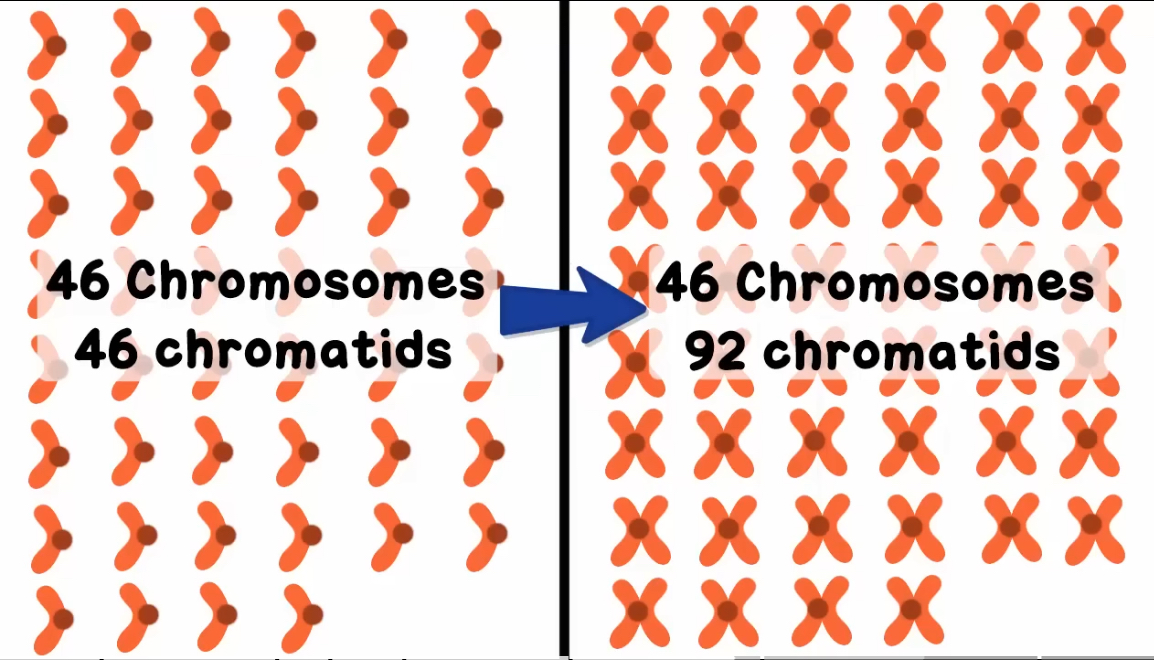
centromere
Part of chromosomes where sister chromatids are held together
Sister chromatids
The chromosomes of a eukaryotic cell are duplicated before they condense and the cell divides. Each chromosome contains two copies called ________ joined copies of the original chromosome held together by proteins.
Sister chromatids
These are joined copies of the original chromosome held together by proteins.
Centromere
The two sister chromatids are attached by proteins to form a region called the _______?
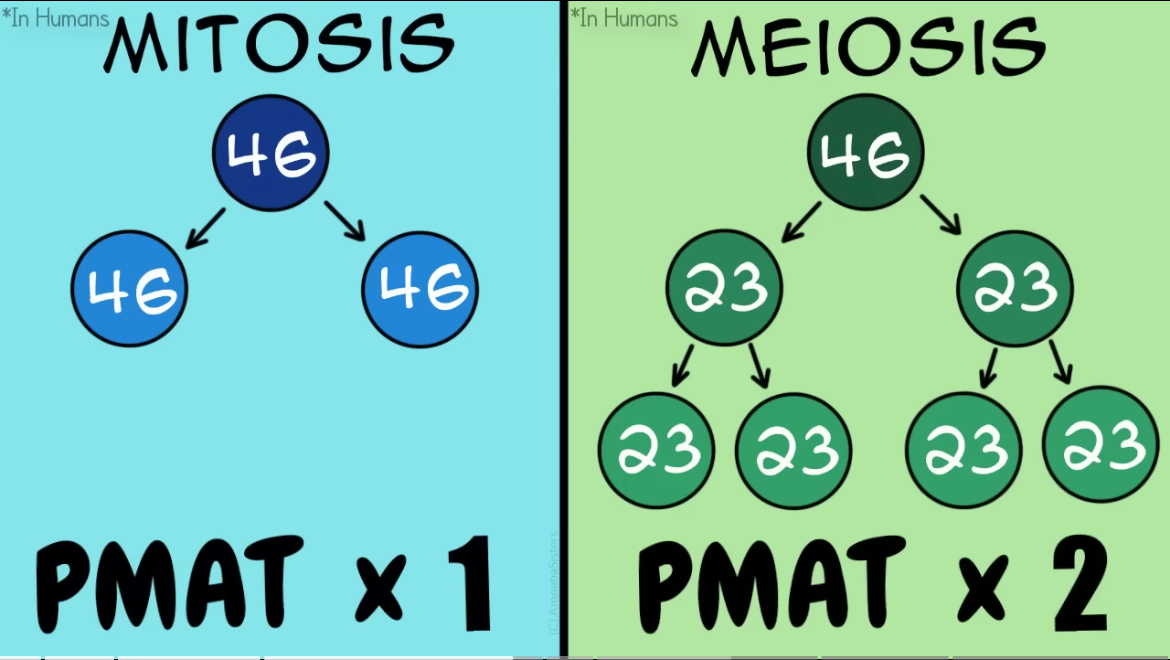
Mitosis
Meiosis
What are the two types of cell division?
Mitosis
During this type of cell division, a cell duplicates all of its contents, including its chromosomes, and splits to form two identical daughter cells. Because this process is so critical, the steps are carefully controlled by certain genes. When it is not regulated correctly, health problems such as cancer can result.
Meiosis
This type of cell division ensures that humans have the same number of chromosomes in each generation.
It is a two-step process that reduces the chromosome number by half—from 46 to 23—to form sperm and egg cells. When the sperm and egg cells unite at conception, each contributes 23 chromosomes so the resulting embryo will have the usual 46.
This type also allows genetic variation through a process of gene shuffling while the cells are dividing.
Mitosis
What type of cell division is being described?
Happens in body cells (like skin, muscle).
Makes 2 identical cells (same DNA).
Used for:
Growth
Replacing damaged cells
Healing wounds
🔹 Example: When you get a cut, mitosis helps make new skin cells.
Meiosis
What type of cell division is being described?
Happens in sex cells (sperm and egg).
Makes 4 cells, each with half the DNA.
Used for:
Sexual reproduction
Creating genetic diversity
🔹 Example: Meiosis creates sperm and egg cells with half the genetic material so they can combine during fertilization.
separate
daughter cell
When the cell divides, the sister chromatids 1. _______from each other and are considered individual chromosomes, and they are identical to the original chromosome. During cell division, a chromosome goes to each _________cell. In this way, each daughter cell receives a complete and identical set of chromosomes.
Cell division
It is the basis of reproduction for every organism. It is a key component of the cell cycle.
Cell cycle
It is an ordered sequence of events that run from the moment a cell is formed until it divides into two cells.
Interphase (growing stage)
Mitotic phase (actual cell division stage)
What are the two main stages that comprise the cell cycle?
Interphase
This is the first stage in a cell cycle, it is where the cell doubles everything in its cytoplasm and replicates DNA
Mitotic phase
It is the second stage in a cell cycle, it is the actual cell division stage.

Interphase (Cell grows)
This is the longest phase where the cell grows, replicates its DNA, and prepares for division.
G1 phase (“first gap”)
S phase (“Synthesis” of DNA)
G2 phase (“second gap”)
What are the three sub-phases of the interphase?
G1 phase
The cell grows, synthesizes proteins and organelles, and prepares for DNA replication.
Which subdivision of the interphase is being described?
S phase
DNA replication occurs, resulting in two identical copies of each chromosome.
Which subdivision of the interphase is being described?
G2 phase
The cell prepares for mitosis, ensuring DNA replication is complete and all necessary components are present.
Which subdivision of the interphase is being described?
Misnomer
This term refers to a wrong or inaccurate name or label for something. It happens when something is called by a name that doesn't really fit or is misleading.
🔹 Examples:
"Starfish" — it's not actually a fish.
"Dry cleaning" — clothes are cleaned with liquid, not dry.
“gap” sounds like nothing is happening, as if the cell is resting — which is not true. The cell is actually very active, growing, producing proteins, and preparing for division.
"Cells are still active throughout all three subphases of interphase, making the “gaps” a misnomer."
Why was it said that “gaps” are a misnomer?
Mitotic phase (Cell divides)
This subphase of the cell division stage refers to the period during which a cell undergoes physical division and is divided into two overlapping stages: Karyokinesis or mitosis and Cytokinesis.
Mitotic phase
This phase involves the division of the nucleus and cytoplasm, resulting in two daughter cells.
Karyokinesis / mitosis
This is an overlapping stage of the Mitotic phase.
This is when the nucleus and its contents (emphasis on the duplicated chromosomes) divide and are distributed into the nuclei of the two daughter cells.
Cytokinesis
This is an overlapping stage of the Mitotic phase which begins prior to the end of mitosis, causes the cell’s cytoplasm to divide into two. The combination of these two produces genetically identical daughter cells and each daughter cell may then proceed through G1 and repeat the cycle.
Eukaryotic cell
Mitosis is unique to which kind of cell?
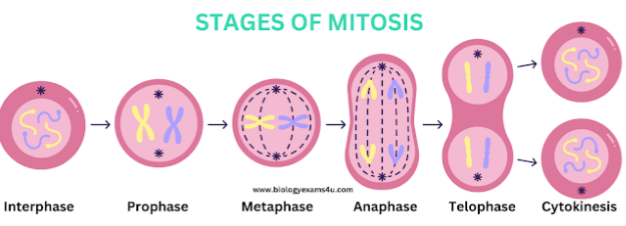
Prophase
Prometaphase
Metaphase
Anaphase
Telophase
P P M A T
What are the five main stages of mitosis?
Chromosomes
What is considered the “star” of the mitotic “dance”.
Their movements depend on mitotic spindle fibers which emerge from the centrosomes.

Prophase
This is the first stage of Mitosis.
Changes occur in both the nucleus and cytoplasm.
In the nucleus, the chromatin forms chromosomes and begins to duplicate into sister chromatids.
In the cytoplasm, microtubules grow from centrosomes forming mitotic spindles that begin to move away from each other.

Prophase
1. _________– "Prep Time"
The curtain opens.
The chromosomes get dressed (condense and become visible).
The nucleus breaks down, and the stage crew (spindle fibers) start setting up.
🎭 The actors are getting ready to perform!
Sa Nuclues, the Chromatin forms chromosomes
Sa Cytoplasm, microtubules grow from centrosomes forming mitotic spindles
Prometaphase
The nuclear envelope dissolves.
Microtubules extend into the nuclear region and reach the chromosomes.
Each sister chromatid contains sites called kinetochores where some of the spindles attach.
The spindles move chromosomes toward the center of the cell.
Kinetichores
Each sister chromatid contains sites called ______where some of the spindles attach.
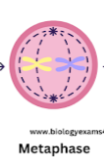
Metaphase
The mitotic spindle is fully formed, with its poles at opposite ends of the cell.
The chromosomes line up on an imaginary plate in the middle of the cell called a metaphase plate, with the centromeres lined up on the plate.
For each chromosome, the kinetochores of the sister chromatids are attached to opposite spindles from each pole.

Metaphase
2. _________– "Line Up!"
All the chromosomes line up in the middle of the stage (the metaphase plate).
The spindle fibers attach to each chromosome.
🎭 Everyone is in position, ready for the next act!

Anaphase
The centromeres come apart, separating the sister chromatids towards opposite poles of the cell.
As this happens, the spindle microtubules attached to the chromatids shorten while those unattached lengthen.
This moves the poles further apart so that by the end of this stage, there are equal collections of chromosomes on the two poles

Anaphase
3. __________– "Split Up!"
The chromosomes are pulled apart and move to opposite sides of the stage.
🎭 Time for the dramatic twist—actors split and run to both sides!

Telophase
The cell continues to elongate.
Daughter nuclei appear and the nuclear envelope begins to form around the chromosomes.
In terms of process, this is like the reverse of what occurred in the prophase.
By the end of this stage, the chromatin uncoils and the mitotic spindle disappears.

Telophase
4. __________– "The End"
The chromosomes reach the sides, and new curtains (nuclear membranes) close.
The stage is reset, and everything gets back to normal.
🎭 The play ends, and the set is cleaned up for the next show.
Cytokinesis
Bonus Stage: __________– "Clean Break"
The stage (cell) splits into two — each with its own cast (nucleus).
the division of the cytoplasm simultaneously occurs with telophase and differs between animal and plant cells.
🎭 Two stages now, each ready for their own show!
cleavage furrow
In animal cells, cytokinesis occurs by cleavage and it appears as a cleavage ______, a shallow groove on the cell’s surface. This site has a ring of microfilaments that ultimately contract and pinches the cell into two.
cell plate
In the case of plant cells, the stiff cell wall prevents contraction. What happens is that during telophase, vesicles containing cell wall material collect at the middle of the parent cell, forming a disk called a ______.
This grows outward, accumulating more cell wall material as vesicles fuse with it until it fuses with the plasma membrane and the cell plate joins the parental cell wall.
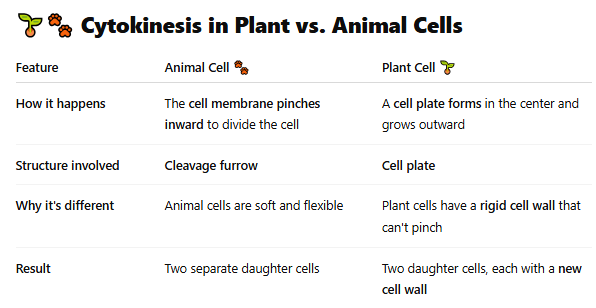
In animal cells, cytokinesis occurs through a cleavage furrow that pinches the cell in two.
In plant cells, a cell plate forms between the two nuclei and eventually becomes the new cell wall.
Why is Cytokinesis different in animal and plant cells?
Meiosis
This mechanism refers specifically to sex cells
Somatic cell
This refers to any cells in the body that are not germ cells (sperm or egg cells).
They are diploid, meaning they contain two sets of chromosomes (46 total), one from each parent.
These cells compose the body's tissues and organs, and they divide through mitosis.
Germ cells
cells that are the cells responsible for the sexual reproduction of new organisms.
diploid as well, however they can only be found in the gonads.
derived from the primordial streaks of the embryo.
Using this, Gametes are created
Both mitosis and meiosis occur during their development.
The mutation is passed down from generation to generation.
Somatic cells
Regular body cells that repair and reproduce tissues
The source of these cells are stem cells
They undergo Mitosis
Mutation is not passed down
Somatic cells
make up the majority of your body’s cells.
They include skin cells, bone cells, red blood cells, and a number of other cells.
are diploid, meaning they contain two complete sets of chromosomes.
Gonads
These are the organs that produce gametes (sex cells) and hormones related to reproduction.
are the organs that produce gametes (sex cells) and hormones related to reproduction.
Haploid cells
Gametes have only one pair of chromosomes or just 23 chromosomes, which means they are?
Homologous chromosomes / pair
Almost every chromosome has a twin that resembles it called ________ chromosomes (or ________pair) because each chromosome carries genes controlling the same inherited characteristics.
Genes
These are structures that contain inheritable traits
locus (plural loci)
What particular place in the chromosome can we find the inheritable traits?
Female (XX)
Kapag homologous pairs of X chromosomes (XX) anong sex?
Male (XY)
Kapag isang X at Y chromosome, anong sex?
Sex chromosomes
These types of chromosomes determine an individual’s sex
Autosomes
🧬 In humans:
We have 46 chromosomes in total.
44 of them are autosomes (organized into 22 pairs).
The remaining 2 chromosomes are sex chromosomes:
XX = female
XY = male
These are the non-sex chromosomes that carry most of the body’s genetic information, such as traits for hair color, height, and blood type.
Diploid number
The total number of chromosomes in an organism is called the _________(abbreviated 2n, this is equal to 46 in humans for example). The exceptions are the gametes as each contains a single set of chromosomes.

✅ Yes, but only in gametes (sperm and egg cells).
❌ No, in body (somatic) cells.
🧬 Example:
A sperm cell might carry X or Y
An egg cell always carries X
After fertilization (X or Y + X), the resulting zygote is diploid and has 2 sex chromosomes
Are sex chromosomes haploid?
reproductive organs
In which organs does Meiosis occur?
MEI = HATI / HALF
Meiosis
It is the type of the cell division that produces haploid gametes in diploid organisms.
Meiosis I
Meiosis II
It is accompanied by a Roman numeral to describe whether the sex cell is undergoing the first or second cell division.
Many of the stages of meiosis closely resemble corresponding stages in mitosis. Both preceded by replicating the chromosomes in interphase but in meiosis, this duplication is followed by two called _____ and _______
Basically, ang Meiosis wala lang siyang prometaphase
Prophase I
Which stage in Meiosis I is being described in the following:
Homologous chromosomes, composed of two sister chromatids, come together in pairs forming a tetrad, four chromatids aligned gene by gene.
Crossing over, one of the most important events in meiosis occurs, that is chromatids exchange segments with one chromatid of the other homologous pair. This rearranges genetic information.
As this continues, the chromosome coil, the nuclear envelope dissolves, and the tetrad is captured by the spindle microtubules and moves them to the center of the cell.
Metaphase I
Which stage in Meiosis I is being described in the following:
The tetrads are aligned on the metaphase plate. The spindles are attached to the kinetochores at the centromeres. In each tetrad, the homologous chromosomes are held together at the sites where crossing over took place.
For each tetrad, the spindle from opposite poles of the cell attaches to one of the homologous pairs. This arrangement directs each tetrad to move toward opposite poles of the cell.
Anaphase I
Which stage in Meiosis I is being described in the following:
This stage is marked by the migration of chromosomes toward the poles of the cell.
In contrast to mitosis, the sister chromatids remain attached and only the tetrads which contain sites of cross-over split up.
Telophase I (and simultaneously Cytokinesis).
Which stage in Meiosis I is being described in the following:
The chromosomes arrive at the poles, resulting in each pole having a haploid set of chromosomes.
After cytokinesis, two haploid daughter cells are formed.
True
True or False
In some organisms, interphase follows before meiosis II. In others, meiosis II ensues. In either case, no duplication of chromosomes occurs in-between.
Meiosis II
Which type of meiosis is being described?
It can be summarized as sister chromatids separating and are essentially the same as mitosis.
The difference is that meiosis II starts with a haploid cell.
What is the difference between Meiosis I and Meiosis II?
ZygoteThese
When the haploid sperm from the father fertilizes a haploid egg from a mother, the resulting fertilized egg is called a ______? and it will contain one set of homologous chromosomes from each parent.
Tumor cells
These cells, if left unregulated, may become lethal by becoming cancers in the body.
D. All of the above
1. Which of the following is shared by all cells?
a. Plasma membrane
b. Cytosol
c. Ribosome
d. All of the above
C. Microscope
2. Instruments that allow us to see and view cells.
a. Telescope
b. Magnifying Glass
c. Microscope
d. Eye Glasses
D. Nuclear pores
3. This part of the nucleus acts as gates that control substances that enter or exit it.
a. Nuclear Membrane
b. Nucleoplasm
c. Nucleolus
d. Nuclear Pores
b. Rough ER
4. Which part of the eukaryotic cell performs protein synthesis?
a. Smooth ER
b. Rough ER
c. Golgi Apparatus
d. Mitochondria
B. Peroxisome
5. Cell organelle that specifically breaks down fatty acids.
a. Lysosome
b. Peroxisome
c. Centriole
d. Ribosome
C. All of the above
6. Which of the following are considered a cell type?
a. Prokaryotic
b. Eukaryotic
c. All of the above
d. None of the above
B. Chloroplast
7. Which organelle is found in plant cells and absent in animal cells?
a. Nucleus
b. Chloroplast
c. Cytoskeleton
d. Centrosomes
A. Plasma Membrane
8. The following organelles manufacture, distribute, or break down molecules except?
a. Plasma Membrane
b. Endoplasmic Reticulum
c. Golgi apparatus
d. Vacuole
D. Flagella
9. This part of the prokaryotic cell is primarily used for locomotion. a. Nucleoid
b. Pili
c. Capsule
d. Flagella
A. Nucleus
10. Which organelle in a eukaryotic cell can perform genetic control?
a. Nucleus
b. Cell Wall
c. Mitochondria
d. Lysosome
C. Microfilaments
11. The cilia of Paramecium belong to which cytoskeletal fiber?
a. Microtubules
b. Intermediate Filaments
c. Microfilaments
d. None of the above
C. Gap Junction
12. This cell junction type is also known as a “communicating junction”.
a. Tight junction
b. Anchoring junction
c. Gap junction
d. Plasmodesmata
A. Pectin
13. A sticky substance between two plant cells that links them together.
a. Pectin
b. Lignin
c. Cellulose
D. Glycoprotein
A. Microtubules
14. This type of fiber that makes up the cytoskeleton is composed of tubulins.
a. Microtubules
b. Intermediate Filament
c. Microfilament
d. Extracellular matrix
B. Anchoring Junction
15. What junction type is connected to the cytoplasm through intermediate filaments?
a. Tight junction
b. Anchoring junction
c. Gap junction
d. Plasmodesmata
A. Diffusion
16. This passive transport mechanism is a direct result of the innate thermal energy of molecules.
a. Diffusion
b. Osmosis
c. Facilitated Diffusion
d. None of the above
D. Pinocytosis
17. A type of active transport where cells are able to engulf small fluid particles.
a. Exocytosis
b. Phagocytosis
c. Receptor-mediated endocytosis
d. Pinocytosis
B. Crenation
18. The process where animal cells shrivel due to an imbalance in solute concentrations refers to?
a. Plasmolysis
b. Crenation
c. Turgidity
d. Tonicity
B. Osmosis
19. This special type of passive transport is exhibited by water molecules on selectively permeable layers.
a. Diffusion
b. Osmosis
c. Facilitated Diffusion